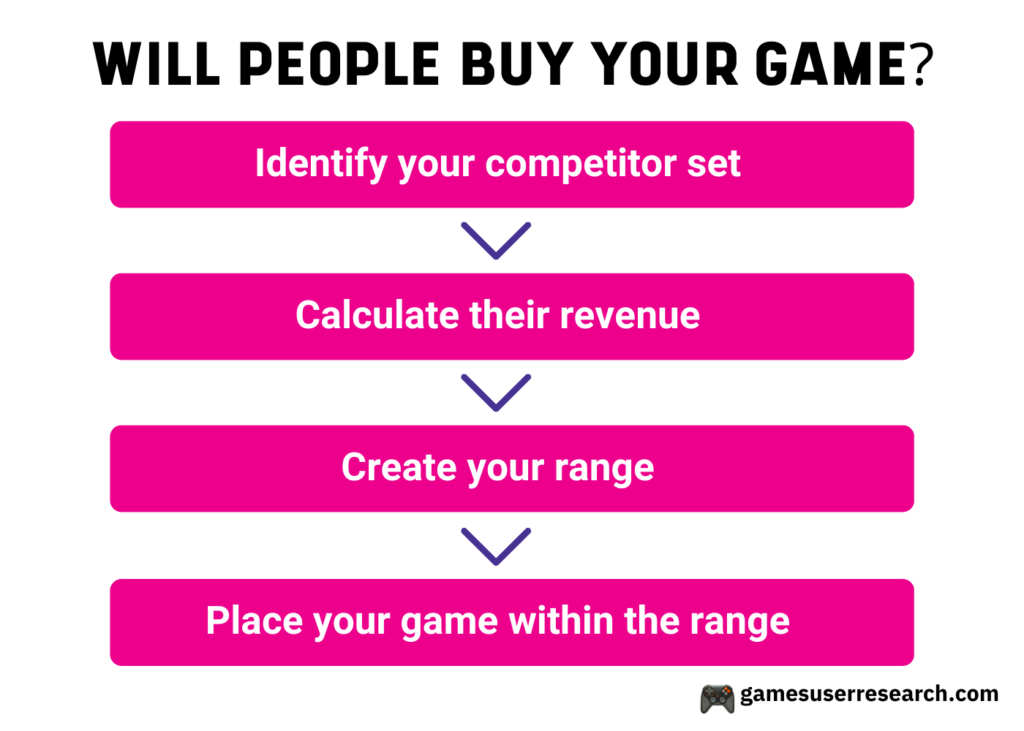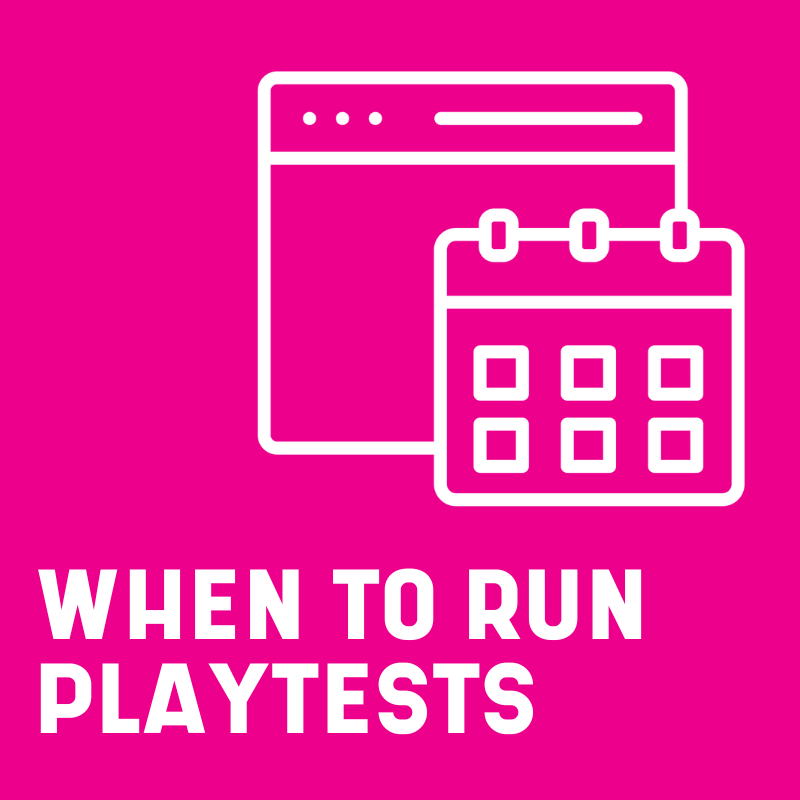Games are a balance of creativity and business. For some developers, sales aren’t important.
Thousands of hobbyist developers are making games as passion products. For some of them, understanding the needs of players is less important than creativity – they are not expecting or aiming to sell their game at a scale that it will fund itself.
And this is fine – games are art, and the creation of art is important.
For everyone else, selling games is important – to keep the studio alive, to ensure people get paid, and to make sure that the team survive to make a second game.
If you’re working on a professional game development team, it’s essential to understand the market and de-risk your game idea as early as possible.
In this post, I’ll cover a process for how to do this. This isn’t strictly ‘user research’, and I’ll reference some practices from the market research community. However, we can apply our expertise and the rigour of user research to build upon the market research process, and provide deep data game developers can trust.
Learning as early as possible whether players will buy your game is essential for studios to survive. Let’s learn how.
Players cannot tell you directly
Sometimes the obvious approach is wrong.
You’d imagine that we could just run a big survey of players, ask them “would you buy this game?”, and then extrapolate out to anticipate whether the game will be successful.
Unfortunately, this approach is flawed.
Asking “would you buy this game?” relies on players anticipating their future behaviour. This is not a reliable way of capturing data we can trust. Not because players are intentionally lying, but because humans just don’t work like that.
When asked, people will give rational, well-thought-out answers, based on what they hope they will do, in the belief they act rationally. But that’s not how people actually act. Most decisions are made subconsciously and reactively and are subject to a lot of context that we cannot possibly anticipate in advance.
It’s just not accurate. And if we assume it’s accurate, we will make poor decisions based on this data. Junk in, junk out.
Players can’t tell us about their future behaviour. But they can tell us about what they’ve done before. We need to move away from what players believe they do, to their actual past behaviour.
Calculate the potential revenue for your game
Instead of asking players to tell us, we need to take an approach based on behavioural data. To do that, we’ll first work out the spread of potential sales for your game, and then understand player behaviour to see where your game will within that range.
This process to identify your potential revenue was described by Cassia Curran in her 2021 talk at Develop conference.

Start by identifying your competitor set
First, work out what games are within your competitor set – other games your players will be playing.
Your competitor set is likely to be games similar to yours in scope and genre. You might know some already, and can discover more whenever you are interviewing players by asking “what other games are you playing” and looking for ones that occur commonly.
Looking at the “more like this” on the Steam page for known competitors will also give an idea of other potential competitors.
Cassia advises focusing on more recent games (because trends in the games industry move fast, and these will more closely represent what players are buying today), and ensuring that you’re not just going for the big ‘famous’ games, but also seeking out smaller games within your competitor set.
🚀 Do this now: Create a list of ten to twenty games in your competitor set.
Estimate the earnings of those games
The ‘boxleiter’ number, and iterations of it since, aim to estimate game sales based on the number of wishlists a game has. This allows you to then anticipate their earnings.
Luckily the calculations don’t have to be done manually. The website steam-revenue-calculator allows you to type in the USD price, and the number of wishlists, and come up with an estimate of revenue.
This number obviously has a whole bunch of caveats around it, because prices change over time, but it’s a reasonable estimate we can work with – which can then be refined by post-mortems or just asking the developers themselves!
🚀 Do this now: Work through games in your competitor set, and create a spreadsheet showing the range of prices your game could achieve.
This will show the range of revenue for competitors.
Create your range
Having got your list of competitors, you can visually represent this data to come up with a range for your own game by calculating the quartiles and representing this on a box plot.
In this example, we can see that most games of this genre earn between $160k, and $2.1 million.
A template for calculating this is available within the Playtest Kit.
Find where your game sits in the range
That’s still quite a big range. In the example above, the range of potential sales is almost $2 million dollars, which can be the difference between a successful game, or the studio closing.
You want to understand where you fit in that range. Qualitative research will help you work out where to place your game in that range.
To do that, you need to find and interview players from your competitor set. This should be part of your process for defining your players, done during the ideation or pre-production stages of game development. Your focus in these interviews needs to be on previous purchase and playing behaviour around competitor games.
You’re looking for specific examples of when they have decided to buy, or not buy a competitor game, and their reasons for playing it, or abandoning it. To move beyond generalities, we want to ask questions that encourage players to walk through past behaviour, such as starting with “tell me about a time you…”
Some questions should include:
- Tell me about <<competitor game>>
- When did you first hear about <<competitor game>
>? - Tell me about what you did next
- When did you buy it?
- What made you decide to buy it?
- How did you buy it?
- What happened next?
- What was your first experience of playing <<competitor game>
> - What was good
- What was bad
- How frequently do/did you play <<competitor game>
>? - Why that frequency?
- Do you still play <<competitor game>
> - Why/why not?
This will generate more genuine descriptions of past behaviour – which is predictive of future behaviour, and a lot safer than asking people to directly guess what they will do in the future.
Running these interviews with multiple participants, across multiple competitor games, will start to generate behavioural themes. Thematic analysis will reveal how and why players play these other games.
You can then assess your own game against those pillars from other games, to get a feel for where your experience will fit within the pack. Is the experience you are making most similar to those at the top of the scale? Or is it more similar to those nearer the bottom of the pack? This will help place where you should expect your game to land in the range, and give a steer of sensible objectives for early user research studies.
Validate as early as possible
Making games professionally is a unique combination of creativity and business.
Within business, our goal in understanding players is to de-risk development. By following this process we’ve started to get an idea of the potential revenue your game idea will generate, and what would lead players to place your game high or low within that range.
However regular check-ins are required to make sure development is on track, and that the experience you are making matches the experience you intend to make. Regularly exposing prototypes and in-development builds to players will create opportunities to notice early if your game is failing to reach its potential, and pivot early.
In those sessions, combine observations and interview questions to ensure that players enjoy your game, and it’s hitting the core pillars you identified above.
Because games are creative, you also need to be careful not to defer decision-making to players. Don’t let player’s opinion be your sole guide for your decisions – you are the designer and creator, and so need to be in charge. This process works best as just one data-point, combined with your own expertise, about whether your game development process is on track.
Integrate player insight throughout development
Every month, get sent the latest article on how to plan and run efficient high quality playtests to de-risk game development. And get Steve Bromley’s free course today on how to get your first 100 playtesters for teams without much budget or time.
Plus your free early-access copy of ‘Playtest Plus’ – the essential guide to the most impactful playtests to run throughout development of your game



